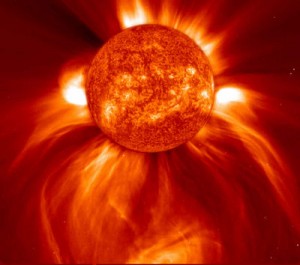The idea that ‘all energy comes from the sun’ had stuck in my mind for years, after a dinner conversation with an artist friend Julian Priest who had trained in physics. Though a simplification, this lens began to reveal to me the transmutation of energy across all forms of matter on the planet including all life. I felt this as a significant shift in my own way of viewing the world. It would clarify for example ‘fossil fuels’ such as oil, as ultimately the ancient sunlight stored by the great forests of the Carboniferous Period some 400 million years ago.
Julian would later work to refine and reframe this – quantitative and industrially useful – idea of energy in terms of the information and entropy flow of non-linear thermodynamics. The artwork All Information Comes from the Sun,[1] discusses this reframing and was supported in a weekend residency at House of Wonder, in preparation for its exhibition as part of the Intercreate exhibition Second Nature at ISEA 2011 in Istanbul, Turkey.
That first conversation had for me however, developed a fascination for this transmutation of energy/information, from such seemingly simple beginnings to dissipate and recombine into the complex systems of exchange that continue to emerge from it, including my own daily energy/information exchanges.
| On-farm installation of the timeline, and demarcated on google maps. The ‘Basins Group Era’ is thought to mark the emergence of life, and is the 3rd marker on the timeline. |
In developing a physical walk through a history of the earth in September, it had surprised me to see how early the first life is thought to have appeared. Also that it would come in the midst of a hostile planet of exploding volcanoes, crashing meteorites and chemical chaos – repetitively crushed and each time resurging.
In a major school of thought, the first life is believed to have formed in the relative calm of geothermal vents on the ocean floors. These ancient thermophiles, managed to survive in and utilise the energy of this environment of extreme heat. I was intrigued – how did these thermophiles go from the energies of chemical matter and reactions to a form of ‘life’?
Of cultural significance as an origin story, it is a research area that also involves far-flung future possibilities, as thermophiles serve as analogues in the continuing search for life on other planets such as Mars. As it happens, in Aotearoa New Zealand, our rapidly mineralising geothermal systems have entombed this biota, attracting global interest and bringing many foreign researchers, such as geologists and astrobiologists, to study our siliceous hot springs.[2] The thermal activity sited on a long geological rift stretching from the Hauraki Gulf to the Taupo Basin, which includes our humble local Miranda Hot Springs.
I would find that similar stories of adaption to energy sources repeat and complexify through the timeline as one story of our evolving world. The repeating story of processing, storing and utilising what was originally either solar, geothermal or some form of chemical/atomic energy. Dividing, multiplying till all the surface of the planet is teeming with complex life. For as ecologist Keith Thompson would put it, ‘Life is just organic chemistry with legs and its all about dynamic equilibrium, efficiency and adaptation’.
In conversations with Keith and Julian, I was pointed to those areas within ecology and physics that analyse these systems of energy exchange and entropy (or information loss) – such as non-linear thermodynamics, and an area that is sometimes called complexity studies.
In reflecting on this, I was interested for the November Wonderlogue event to, as Sally Jane Norman and Sylvia Nagl eloquently put it, encourage reflection on ‘our embeddedness within complex systems and our own embodied nature as complex systems’ (Norman & Nagl, 2007). I was curious to continue to create a more physical experience, as a way to develop an embodiment of knowledge. This would also I hoped, allow for a social environment which would more easily invite reflection from knowledge and cultural perspectives other than science, on the significant elements of worldview and identity that the topic of ‘deep time’ encompasses – ideas of origins, ancestors, time, energy and futures.
How might for example, those knowledgeable in ideas of whakapapa within matauranga Maori relate to this linear timeline of ancestors? What were the marker points within philosophical ideas on time, space, connectivity or other that a philosopher might be relevant?
Again a breadth of knowledge areas that I could never cover on my own, this approach reflects my overall research strategy. I am interested in using my own fascinations with deeply complex topics to be able to intrigue, invite and welcome a far-flung mix of expertise into a discussion where the greatest exchange occurs between participants, for the reflection and learning of all present. Thus as an artist/curator, I am open to a dialogic aesthetic that might ‘suggest a very different image of the artist, one defined in terms of openness, of listening … and of a willingness to accept a position of dependence and intersubjective vulnerability relative to the viewer or collaborator’ (Kester).
As a result the day was organized so that the guests would experience a combination of travelling to and being welcomed to a place, being part of the social rituals of sharing food and self-introductions, followed by a physical walk through and alongside our ancestors of energy processors, and finally soak their bodies and minds in a ‘heated conversation’ in the geothermal energy of the Miranda Hot Springs, now transformed into an immersion into this originating environment for life.
